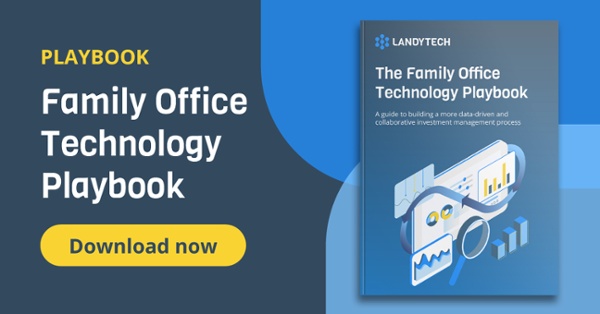Written by Landytech
25 May 2023/Blog%20and%20content%20images/Private-Asset-Reporting-Blog_v01.jpg?width=600&height=314&name=Private-Asset-Reporting-Blog_v01.jpg)
For many years, alternative investments including private equity, hedge funds, real estate were seen as nothing but satellite allocations in the portfolios of asset owners. This made the job of family offices comparatively simpler when it came to reporting. Investments could be segmented in clear groupings of equities, fixed income and cash. Any alternatives would simply be grouped together and added as a single line item at the end of reports.
But in recent years, as higher risk-adjusted returns have been harder to achieve, popularity in alternative investments has surged, presenting family offices with a considerable reporting challenge. According to a recent family office report by Goldman Sachs allocations to alternatives now account for 44% of family office holdings.
With alternatives taking up such a sizeable amount of holdings, family offices need to find ways of better incorporating these investments into consolidated reporting, portfolio analytics and cash flow modelling. Many asset owners expect to receive private asset reporting that is of a similar standard and granularity as those for their publicly listed investments.
In this blog we highlight the top five challenges that family offices face when it comes to reporting on alternative investments and the role technology can play in relieving much of this burden.
1. Sourcing alternative investment data
One of the first challenges family offices face when producing alternative investment reporting is sourcing the requisite data. Although some data for alternative funds may be retrievable through a direct daily feed from a custodian, most is still stored in various spreadsheets and file formats that requires manual data entry into reporting systems. It is no surprise that this creates errors, is time-consuming and costly to maintain.
Family offices need technology that can automatically digest, validate and extract the unstructured data of these various document types. This frees up staff that were previously burdened with manual data processes, to redirect their time towards higher value work.
2. Consolidated reporting with public investments
Where previously alternatives were treated as a satellite of family office portfolios, these now form an integral part of the asset allocation strategy for many family offices. That means whenever beneficiaries have questions regarding their total net worth, investment performance, exposure and risk, it is vital that all alternative investments are incorporated in this reporting to provide a truly holistic picture.
One of the key challenges of producing consolidated reporting manually is the compilation of data from various systems, banking portals and data providers. This is complicated by the complex nature of modern family office portfolios that now span multiple asset classes, geographies and investment vehicles. A robust investment management platform for family offices should alleviate much of this burden with automated data sourcing and consolidated reporting at the click of a button.
3. Producing better analytics for alternatives
As allocations to private equity and hedge funds grow, the analytics requirements of family offices and beneficiaries grows too. Where previously there may have been as little as a quarterly valuation from a fund manager that was passed on to beneficiaries, family offices now need to produce private equity specific analytics and fee breakdowns for hedge funds.
Analytics providers such as MSCI have also been developing their offering for asset owners. MSCI has a multi-asset class factor model, which is far more likely to be of relevance to family offices than the traditional equity-only models. These models allow family offices to understand their exposures to asset classes such as private equity and hedge funds in much greater depth, in addition to gaining a deeper knowledge of the drivers and detractors of performance and risk within their portfolios.
4. Monitoring cashflows and liquidity position
Understanding the liquidity and cashflow position of the family is integral for family offices to keep a track of when managing alternative investments. When it comes to venture capital and private equity funds, there will be capital calls the family will be expected to meet at various points in a fund's lifecycles. It is vital that family offices are in a position to meet these calls without having to liquidate unnecessarily. For that reason, family offices need a technological solution that can enable them to model capital calls and distributions in order to have a more accurate picture of future cashflows.
5. Creating a tech stack that incorporates alternatives
As allocations to alternative investments continues to grow, family offices will be inundated with documents relating to valuations and transaction details. These may arrive in disparate frequencies, and across varying time intervals. To ensure staff are not bogged down in many hours' worth of data input and standardisation, family offices need a solution that can enable them to extract this information as efficiently and as accurately as possible. Solutions that have been intentionally developed to accommodate even the most complex alternative asset allocations are best placed to help family offices realise these benefits.
Rising to the challenge
With alternative assets taking up almost half of the holdings of families, family offices need robust systems that can account for these investments at every stage of the investment management lifecycle, from data sourcing through to analytics and reporting. Such a platform will enable family offices to seamlessly consolidate reporting across alternative and traditional investments, in addition to enabling them to make more informed investment decisions with advanced portfolio analytics and cash flow modelling at their fingertips.
Find out how family offices can solve even the most complex data and reporting challenges in our latest whitepaper.
Related Content

The Top 10 Family Office Trends in 2024
To say the current economic environment is complex would be an understatement. With interest rates high and structural economic headwinds persisting, many economists believe we are in a “rolling recession” — a slow-growth period with industries...

How your family office should be sourcing wealth data
As today’s UHNW become more geographically dispersed and family officesbecome more sophisticated in their investment functions and allocation strategies,portfoliosnowconsist of multiple asset classes, custodians and currencies, and investments...

5 ways to improve productivity in your family office
As family offices attempt to modernise, many are facing productivity challenges due to out-of-date, disparate internal systems andheavily manual processes. Naturally, there are inherent risks associated with such inefficiencies, including missed ...



.png?width=1200&height=800&name=HubDB%20Investment%20Hub%20Graphic%20(1).png)


.png?width=800&height=550&name=Asset%20graphics%20for%20website%20(2).png)



